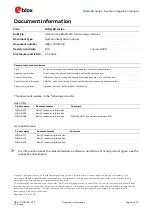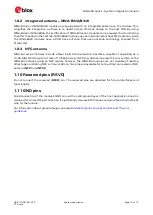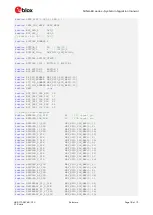
NINA-B3 series - System integration manual
UBX-17056748 - R13
System description
Page 14 of 72
C1-Public
Symbol
Analog function
Connects to
ADCP
ADC single-ended or differential positive input
Any analog pin or VCC
ADCN
ADC differential negative input
Any analog pin or VCC
VIN+
Comparator input
Any analog pin
VREF
Comparator single-ended mode reference
ladder input
Any analog pin, VCC, 1.2 V, 1.8V or 2.4V
VIN-
Comparator differential mode negative input
Any analog pin
Low-power comparator IN+
Any analog pin
LP_VIN-
Low-power comparator IN-
GPIO_16 or GPIO_18, 1/16 to 15/16 VCC in steps of 1/16 VCC
Table 6: Possible uses of the analog pin
1.9
Antenna interfaces
☞
The antenna interface is different for each module variant in the NINA-B3 series.
1.9.1
Antenna pin
–
NINA-B3x1
NINA-B3x1 is equipped with an RF pin. The RF pin has a nominal characteristic impedance of 50
Ω
and
must be connected to the antenna through a 50
Ω
transmission line to allow reception of radio
frequency (RF) signals in the 2.4 GHz frequency band.
Choose an antenna with optimal radiating characteristics for the best electrical performance and
overall module functionality. An internal antenna integrated on the application board or an external
antenna that is connected to the application board through a proper 50
Ω
connector can be used.
While using an external antenna, the PCB-to-RF-cable transition must be implemented using either a
suitable 50
Ω
connector, or an RF-signal solder pad (including GND) that is optimized for 50
Ω
characteristic impedance.
Antenna matching
For optimal performance, the antenna return loss should be as good as possible across the entire
band when the system is operational. The enclosure, shields, other components and surrounding
environment will impact the return loss seen at the antenna port. Matching components are often
required to re-tune the antenna to bring the return loss within an acceptable range.
It is difficult to predict the actual matching values for the antenna in the final form factor. Therefore,
it is a good practice to have a placeholder in the circuit with a
“pi” network, with two shunt components
and a series component in the middle, to allow maximum flexibility while tuning the matching to the
antenna feed.
Approved antenna designs
NINA-B3 modules come with a pre-certified design that can be used to save costs and time during the
certification process. To take advantage of this service, the customer is required to implement an
antenna layout according to the u-blox
The designer integrating a u-blox reference design into an end-product is solely responsible for the
unintentional emission levels produced by the end product.
The module may be integrated with other antennas. In this case, the OEM installer must certify his
design with the respective regulatory agencies.















































